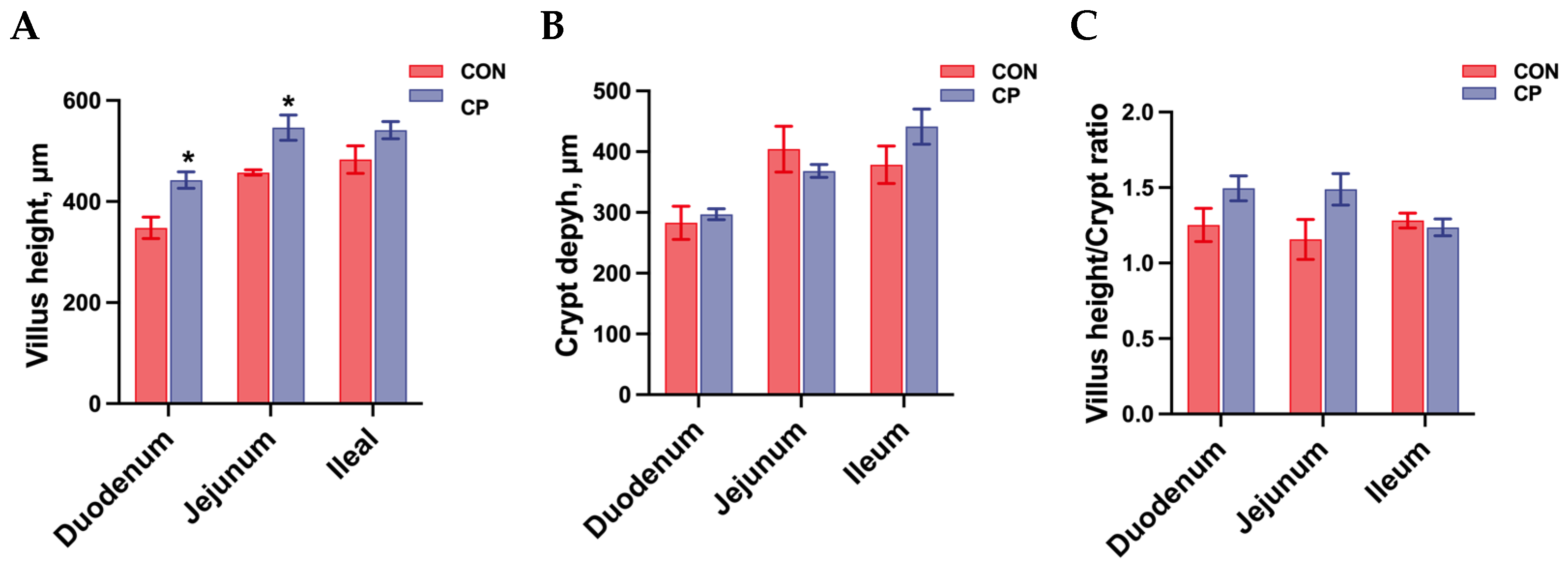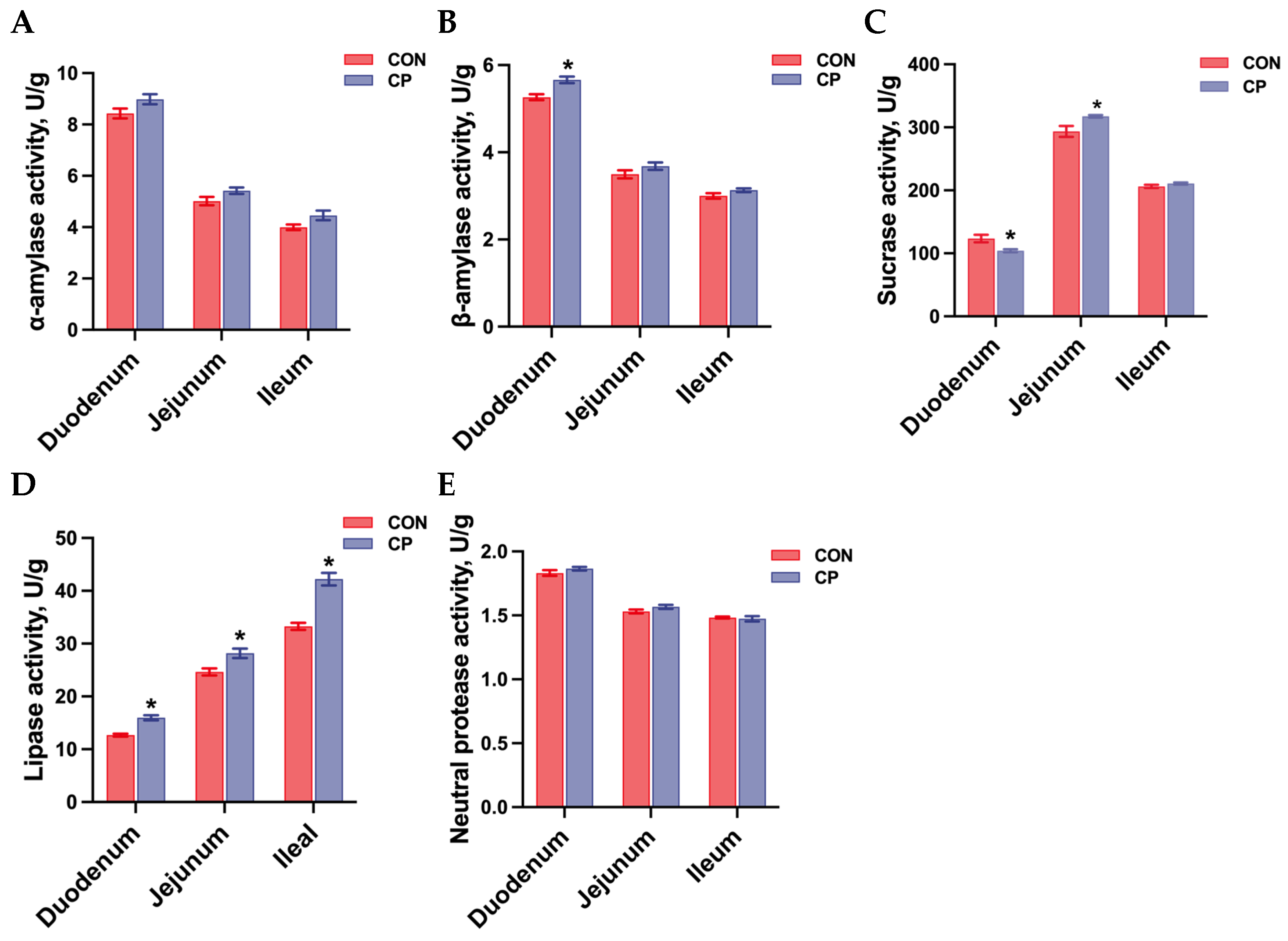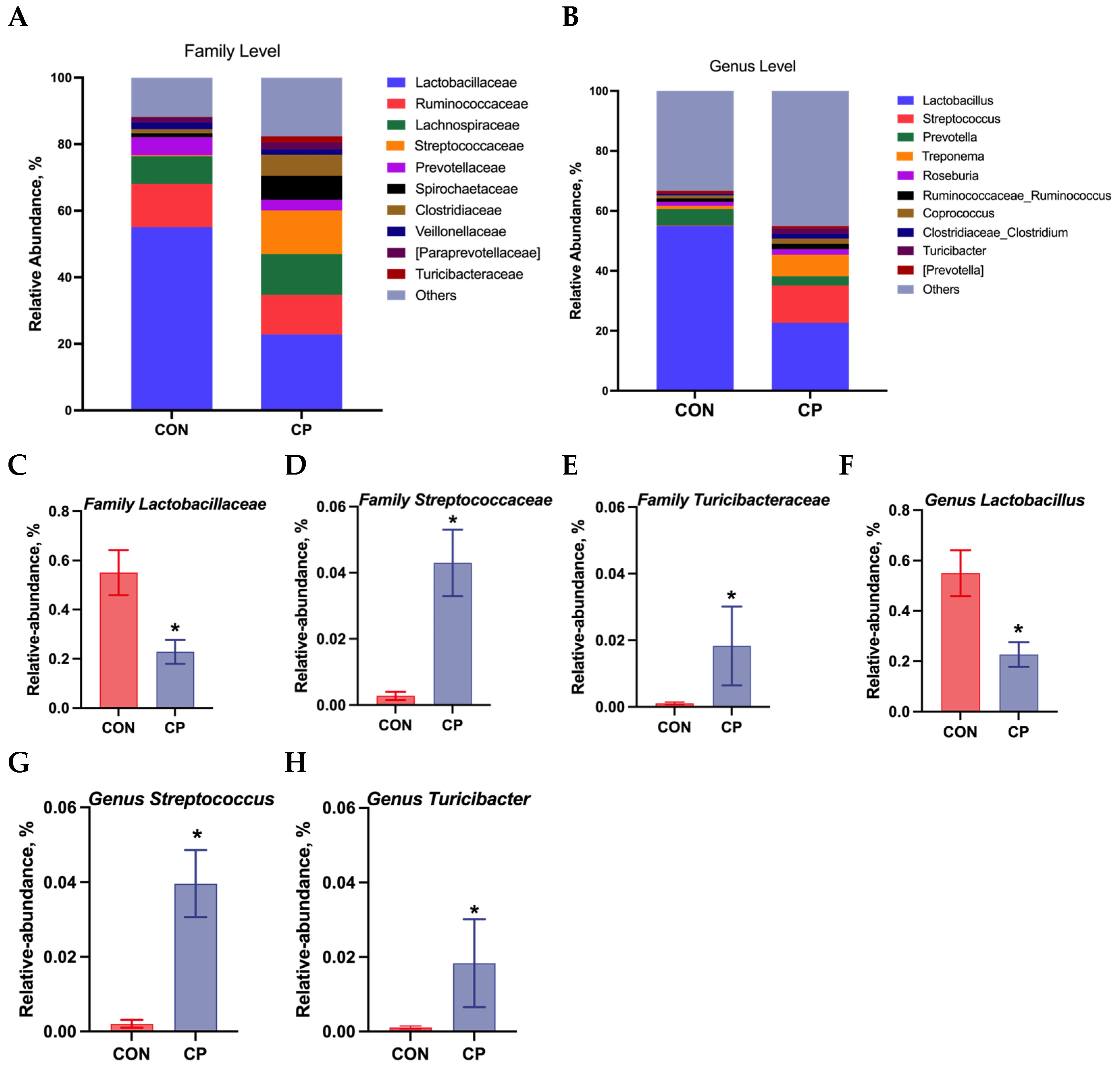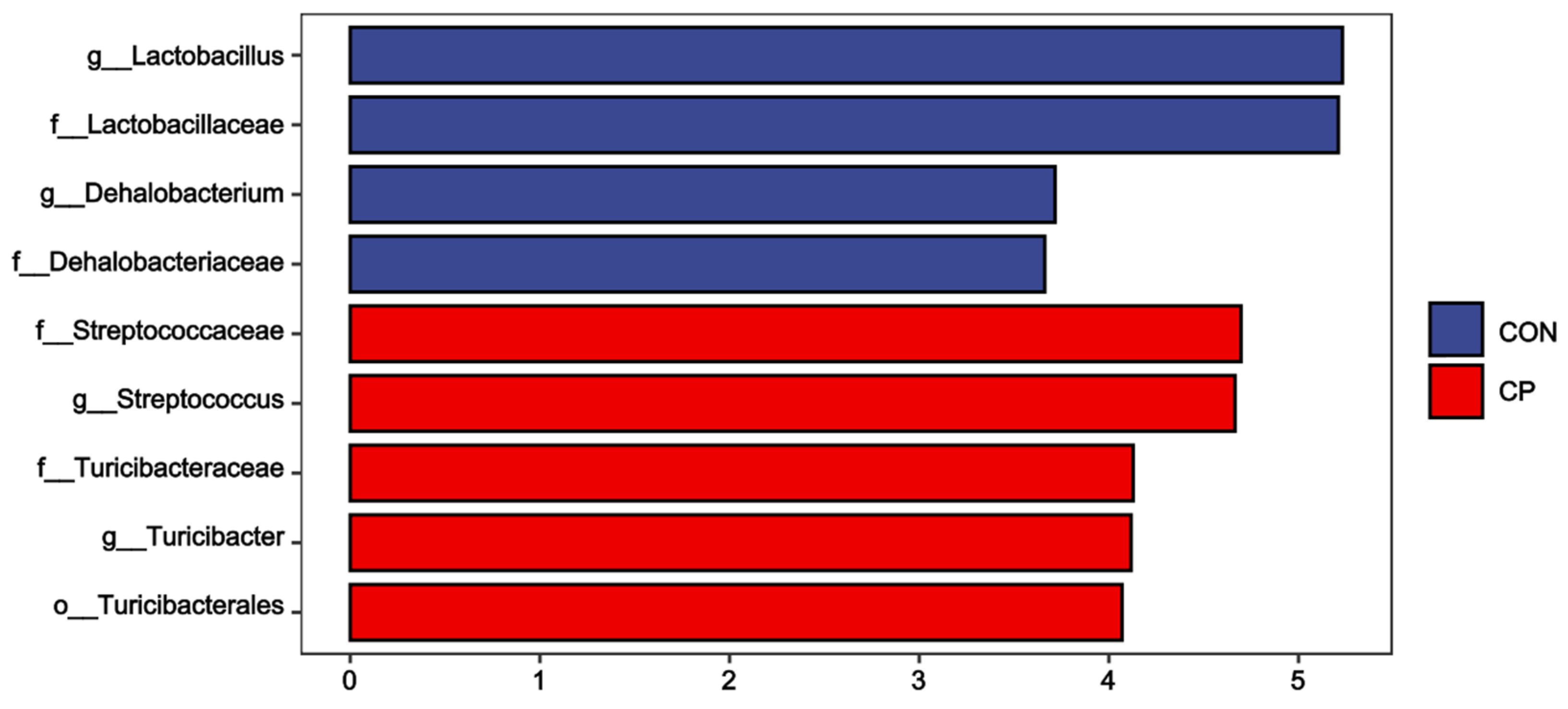Effects of Long-Term Dietary Inclusion of Citrus Pomace on Growth Performance, Intestinal Morphology, Digestive Enzyme Activity, Antioxidant Status, and Colonic Microbiota in Tibetan Pigs
Simple Summary
Abstract
1. Introduction
2. Materials and Methods
2.1. Experimental Design
2.2. Data and Sample Collection
2.2.1. Growth Performance
2.2.2. Sample Collection
2.3. Laboratory Analysis
2.3.1. Intestinal Morphology
2.3.2. Digestive Enzyme Activity in the Small Intestine
2.3.3. Serum Antioxidant Parameters
2.3.4. Colonic Microbiota Analysis
2.4. Statistical Analysis
3. Results
3.1. Growth Performance
3.2. Intestinal Morphology
3.3. Digestive Enzyme Activity in Small Intestine
3.4. Serum Antioxidant Status
3.5. Diversity of Colonic Microbiota
3.6. Composition of Colonic Microbiota
4. Discussion
5. Conclusions
Author Contributions
Funding
Institutional Review Board Statement
Informed Consent Statement
Data Availability Statement
Conflicts of Interest
References
- Yang, K.; Qing, Y.; Yu, Q.; Tang, X.; Chen, G.; Fang, R.; Liu, H. By-product feeds: Current understanding and future perspectives. Agriculture 2021, 11, 207. [Google Scholar] [CrossRef]
- Vastolo, A.; Calabró, S.; Liotta, L.; Musco, N.; Di Rosa, A.R.; Cutrignelli, M.I.; Chiofalo, B. In vitro fermentation and chemical characteristics of Mediterranean by-products for swine nutrition. Animals 2019, 9, 556. [Google Scholar] [CrossRef] [PubMed]
- Kaur, S.; Panesar, P.S.; Chopra, H.K. Citrus processing by-products: An overlooked repository of bioactive compounds. Crit. Rev. Food Sci. Nutr. 2023, 63, 67–86. [Google Scholar] [CrossRef]
- Mahmoud Abdel Gawad, A.R.; Ahamed Hanafy, M.; Mohamed Mahmoud, A.E.; Hassan Al-Slibi, Y. Effect of tomato pomace, citrus and beet pulp on productive performance and milk quality of Egyptian buffaloes. Pak. J. Med. Sci. 2020, 23, 1210–1219. [Google Scholar]
- Tayengwa, T.; Chikwanha, O.C.; Raffrenato, E.; Dugan, M.E.R.; Mutsvangwa, T.; Mapiye, C. Comparative effects of feeding citrus pulp and grape pomace on nutrient digestibility and utilization in steers. Animal 2021, 15, 100020. [Google Scholar] [CrossRef]
- Zhao, H.; Dong, Z.; Liu, B.; Xiong, H.; Guo, C.; Lakshmanan, P.; Wang, X.; Chen, X.; Shi, X.; Zhang, F. Can citrus production in China become carbon-neutral? A historical retrospect and prospect. Agric. Ecosyst. Environ. 2023, 348, 108412. [Google Scholar] [CrossRef]
- Lu, X.; Zhao, C.; Shi, H.; Liao, Y.; Xu, F.; Du, H.; Xiao, H.; Zheng, J. Nutrients and bioactives in citrus fruits: Different citrus varieties, fruit parts, and growth stages. Rev. Food Sci. Nutr. 2023, 63, 2018–2041. [Google Scholar] [CrossRef] [PubMed]
- Wang, L.; Lee, W.W.; Yang, H.W.; Ryu, B.M.; Cui, Y.R.; Lee, S.C.; Lee, T.G.; Jeon, Y.J. Protective effect of water extract of citrus pomace against AAPH-induced oxidative stress in vitro in Vero cells and in vivo in zebrafish. Prev. Nutr. Food Sci. 2018, 23, 301–308. [Google Scholar] [CrossRef]
- Caputo, L.; Quintieri, L.; Cavalluzzi, M.M.; Lentini, G.; Habtemariam, S. Antimicrobial and antibiofilm activities of citrus water-extracts obtained by microwave-assisted and conventional methods. Biomedicines 2018, 6, 70. [Google Scholar] [CrossRef]
- Abbasi, H.; Seidavi, A.; Liu, W.; Asadpour, L. Investigation on the effect of different levels of dried sweet orange (Citrus sinensis) pulp on performance, carcass characteristics and physiological and biochemical parameters in broiler chicken. Saudi J. Biol. Sci. 2015, 22, 139–146. [Google Scholar] [CrossRef]
- Ahmed, S.T.; Mun, H.S.; Islam, M.M.; Kim, S.S.; Hwang, J.A.; Kim, Y.J.; Yang, C.J. Effects of citrus junos by-products fermented with multistrain probiotics on growth performance, immunity, caecal microbiology and meat oxidative stability in broilers. Br. Poult. Sci. 2014, 55, 540–547. [Google Scholar] [CrossRef] [PubMed]
- Lu, J.; Long, X.; He, Z.; Shen, Y.; Yang, Y.; Pan, Y.; Zhang, J.; Li, H. Effect of dietary inclusion of dried citrus pulp on growth performance, carcass characteristics, blood metabolites and hepatic antioxidant status of rabbits. J. Appl. Anim. Ethics. Res. 2017, 46, 529–533. [Google Scholar] [CrossRef]
- Gan, M.; Shen, L.; Fan, Y.; Guo, Z.; Liu, B.; Chen, L.; Tang, G.; Jiang, Y.; Li, X.; Zhang, S.; et al. High altitude adaptability and meat quality in Tibetan pigs: A reference for local pork processing and genetic improvement. Animals 2019, 9, 1080. [Google Scholar] [CrossRef] [PubMed]
- Crosswhite, J.; Myers, N.; Adesogan, A.; Brendemuhl, J.; Johnson, D.; Carr, C. The effect of dietary citrus pulp on the growth, feed efficiency, carcass merit, and lean quality of finishing pigs. Prof. Anim. Sci. 2013, 29, 345–358. [Google Scholar] [CrossRef]
- Cerisuelo, A.; Castelló, L.; Moset, V.; Martínez, M.; Hernández, P.; Piquer, O.; Gómez, E.; Gasa, J.; Lainez, M. The inclusion of ensiled citrus pulp in diets for growing pigs: Effects on voluntary intake, growth performance, gut microbiology and meat quality. Livest. Sci. 2010, 134, 180–182. [Google Scholar] [CrossRef]
- Chen, J.; Jia, X.; Hu, Y.; Zhao, X.; Cheng, Y.; Lu, L.; Zhong, S.; You, J.; Zou, T. Benzoic acid as a dietary supplement mitigates inflammation and intestinal injury in acute enterotoxigenic Escherichia coli-infected mice without adverse effects in healthy mice. Food Funct. 2025, 16, 3195–3210. [Google Scholar] [CrossRef]
- Almeida, V.V.; Nuñez, A.J.C.; Schinckel, A.P.; Alvarenga, P.V.A.; Castelini, F.R.; Silva-Guillen, Y.V.; Thomaz, M.C. Interactive effect of dietary protein and dried citrus pulp levels on growth performance, small intestinal morphology, and hindgut fermentation of weanling pigs. J. Anim. Sci. 2017, 95, 257–269. [Google Scholar]
- O’sullivan, T.; Lynch, P.; Morrissey, P.; O’Grady, J. Evaluation of citrus pulp in diets for sows and growing pigs. Irish J. Agric. Food Res. 2003, 42, 243–253. [Google Scholar]
- Choct, M. Feed non-starch polysaccharides for monogastric animals: Classification and function. Anim. Prod. Sci. 2015, 55, 1360–1366. [Google Scholar] [CrossRef]
- Uerlings, J.; Arevalo Sureda, E.; Schroyen, M.; Kroeske, K.; Tanghe, S.; De Vos, M.; Bruggeman, G.; Wavreille, J.; Bindelle, J.; Purcaro, G.; et al. Impact of citrus pulp or inulin on intestinal microbiota and metabolites, barrier, and immune function of weaned piglets. Front. Nutr. 2021, 8, 650211. [Google Scholar] [CrossRef] [PubMed]
- Zeng, Y.; Dai, X.; Chen, Q.; Liu, Y.; Gifty, Z.B.; Sun, W.; Tang, Z. Effect of dietary pomelo peel powder on growth performance, diarrhea, immune function, antioxidant function, ileum morphology, and colonic microflora of weaned piglets. Animals 2022, 12, 3216. [Google Scholar] [CrossRef] [PubMed]
- Aranda-Aguirre, E.; Robles-Jimenez, L.E.; Osorio-Avalos, J.; Vargas-Bello-Pérez, E.; Gonzalez-Ronquillo, M. A systematic-review on the role of exogenous enzymes on the productive performance at weaning, growing and finishing in pigs. Vet. Anim. Sci. 2021, 14, 100195. [Google Scholar] [CrossRef]
- Gao, X.; Yu, B.; Yu, J.; Mao, X.; Huang, Z.; Luo, Y.; Luo, J.; Zheng, P.; Yan, H.; He, J.; et al. Developmental profiling of dietary carbohydrate digestion in piglets. Front. Microbiol. 2022, 13, 896660. [Google Scholar] [CrossRef]
- Pieper, R.; Scharek-Tedin, L.; Zetzsche, A.; Röhe, I.; Kröger, S.; Vahjen, W.; Zentek, J. Bovine milk–based formula leads to early maturation-like morphological, immunological, and functional changes in the jejunum of neonatal piglets. J. Anim. Sci. 2016, 94, 989–999. [Google Scholar] [CrossRef]
- Song, M.; Zhang, F.; Chen, L.; Yang, Q.; Su, H.; Yang, X.; He, H.; Ling, M.; Zheng, J.; Duan, C. Dietary chenodeoxycholic acid improves growth performance and intestinal health by altering serum metabolic profiles and gut bacteria in weaned piglets. Anim. Nutr. 2021, 7, 365–375. [Google Scholar] [CrossRef]
- Park, S.; Lee, J.J.; Yang, B.M.; Cho, J.H.; Kim, S.; Kang, J.; Oh, S.; Park, D.-J.; Perez-Maldonado, R.; Cho, J.-Y. Dietary protease improves growth performance, nutrient digestibility, and intestinal morphology of weaned pigs. J. Anim. Sci. Technol. 2020, 62, 21. [Google Scholar] [CrossRef]
- Saini, R.K.; Ranjit, A.; Sharma, K.; Prasad, P.; Shang, X.; Gowda, K.G.M.; Keum, Y.-S. Bioactive compounds of citrus fruits: A review of composition and health benefits of carotenoids, flavonoids, limonoids, and terpenes. Antioxidants 2022, 11, 239. [Google Scholar] [CrossRef]
- Liu, Y.; Tang, Y.; Mei, H.; Liu, Z.; Li, Z.; Ma, X.; Luo, Z.; Huang, W.; Li, Y.; Yu, M. Feeding citrus pomace fermented with combined probiotics improves growth performance, meat quality, fatty acid profile, and antioxidant capacity in yellow-feathered broilers. Front. Vet. Sci. 2024, 11, 1469947. [Google Scholar] [CrossRef]
- Armet, A.M.; Deehan, E.C.; O’Sullivan, A.F.; Mota, J.F.; Field, C.J.; Prado, C.M.; Lucey, A.J.; Walter, J. Rethinking healthy eating in light of the gut microbiome. Cell Host Microbe 2022, 30, 764–785. [Google Scholar] [CrossRef] [PubMed]
- Jones, R.B.; Alderete, T.L.; Kim, J.S.; Millstein, J.; Gilliland, F.D.; Goran, M.I. High intake of dietary fructose in overweight/obese teenagers associated with depletion of Eubacterium and Streptococcus in gut microbiome. Gut Microbes 2019, 10, 712–719. [Google Scholar] [CrossRef] [PubMed]
- Zeng, H.; Ishaq, S.L.; Zhao, F.-Q.; Wright, A.-D.G. Colonic inflammation accompanies an increase of β-catenin signaling and Lachnospiraceae/Streptococcaceae bacteria in the hind gut of high-fat diet-fed mice. J. Nutr. Biochem. 2016, 35, 30–36. [Google Scholar] [CrossRef]
- Heidarian, F.; Noormohammadi, Z.; Aghdaei, H.A.; Alebouyeh, M. Relative abundance of Streptococcus spp. and its association with disease activity in inflammatory bowel disease patients compared with controls. Arch. Clin. Infect. Dis. 2017, 12, 10–5812. [Google Scholar] [CrossRef]
- Wang, X.; Chen, H.; Yang, M.; Huang, M.; Zhang, D.; Li, M.; Wang, H.; Zhou, Q.; Lu, L.; Li, Y.; et al. Influence of gut microbiota and immune markers in different stages of colorectal adenomas. Front. Microbiol. 2025, 16, 1556056. [Google Scholar] [CrossRef]
- Zhang, Z.; Lv, J.; Pan, L.; Zhang, Y. Roles and applications of probiotic Lactobacillus strains. Appl. Microbiol. Biotechnol. 2018, 102, 8135–8143. [Google Scholar] [CrossRef]
- Guo, H.; Yu, L.; Tian, F.; Chen, W.; Zhai, Q. The potential therapeutic role of Lactobacillaceae rhamnosus for treatment of inflammatory bowel disease. Foods 2023, 12, 692. [Google Scholar] [CrossRef]
- Parente, E.; Zotta, T.; Giavalisco, M.; Ricciardi, A. Metataxonomic insights in the distribution of Lactobacillaceae in foods and food environments. Int. J. Food Microbiol. 2023, 391–393, 110124. [Google Scholar] [CrossRef] [PubMed]
- Yu, S.; Li, L.; Zhao, H.; Tu, Y.; Liu, M.; Jiang, L.; Zhao, Y. Characterization of the dynamic changes of ruminal microbiota colonizing citrus pomace waste during rumen incubation for volatile fatty acid production. Microbiol. Spectr. 2023, 11, e0351722. [Google Scholar] [CrossRef] [PubMed]






| Item | The Inclusion Levels of Citrus Pomace | |||
|---|---|---|---|---|
| 0 | 5% | 10% | 15% | |
| Ingredient (%) | ||||
| Corn | 56.8 | 61.5 | 57.0 | 52.5 |
| Wheat bran | 12.0 | 2.0 | 1.0 | 0.0 |
| Rice bran | 10.0 | 10.0 | 10.0 | 10.0 |
| Soybean meal | 10.0 | 13.5 | 14.0 | 14.5 |
| Extruded soybean | 6.2 | 4.0 | 4.0 | 4.0 |
| Soybean oil | 1.0 | 0.0 | 0.0 | 0.0 |
| Citrus pomace 1 | 0.0 | 5.0 | 10.0 | 15.0 |
| Premix 2 | 4.0 | 4.0 | 4.0 | 4.0 |
| Total | 100.0 | 100.0 | 100.0 | 100.0 |
| Nutrient level 3 | ||||
| Digestible energy, MJ/kg | 12.98 | 12.94 | 12.94 | 12.90 |
| Crude protein, % | 15.00 | 14.93 | 14.95 | 14.97 |
| Calcium, % | 0.49 | 0.51 | 0.53 | 0.54 |
| Total phosphorus, % | 0.69 | 0.62 | 0.60 | 0.59 |
| Available phosphorus, % | 0.31 | 0.27 | 0.26 | 0.25 |
| Lysine, % | 0.68 | 0.70 | 0.70 | 0.70 |
| Methionine, % | 0.33 | 0.33 | 0.33 | 0.33 |
| Threonine, % | 0.33 | 0.33 | 0.33 | 0.33 |
| Tryptophan, % | 0.10 | 0.12 | 0.12 | 0.12 |
| Item | The Inclusion Levels of Citrus Pomace | p-Value | |||
|---|---|---|---|---|---|
| 0 | 5% | 10% | 15% | ||
| Initial body weight, kg | 16.7 ± 0.7 | 16.6 ± 0.7 | 16.5 ± 0.5 | 16.7 ± 0.8 | 0.990 |
| Final body weight, kg | 48.2 ± 3.2 | 49.9 ± 1.8 | 50.7 ± 0.9 | 47.8 ± 2.8 | 0.150 |
| Average daily feed intake, g | 1213.0 ± 83.9 a | 1146.7 ± 35.5 a | 1326.0 ± 53.4 b | 1196.3 ± 57.8 a | 0.020 |
| Average daily gain, g | 349.6 ± 33.7 | 370.7 ± 34.2 | 380.2 ± 13.6 | 345.2 ± 24.9 | 0.120 |
| Feed conversion ratio | 3.48 ± 0.16 a | 3.11 ± 0.30 b | 3.49 ± 0.24 a | 3.40± 0.27 a | 0.047 |
Disclaimer/Publisher’s Note: The statements, opinions and data contained in all publications are solely those of the individual author(s) and contributor(s) and not of MDPI and/or the editor(s). MDPI and/or the editor(s) disclaim responsibility for any injury to people or property resulting from any ideas, methods, instructions or products referred to in the content. |
© 2025 by the authors. Licensee MDPI, Basel, Switzerland. This article is an open access article distributed under the terms and conditions of the Creative Commons Attribution (CC BY) license (https://creativecommons.org/licenses/by/4.0/).
Share and Cite
Guo, X.; Zhong, H.; Li, J.; Lin, X.; Hu, Y.; Zhang, G.; Chen, J.; You, J. Effects of Long-Term Dietary Inclusion of Citrus Pomace on Growth Performance, Intestinal Morphology, Digestive Enzyme Activity, Antioxidant Status, and Colonic Microbiota in Tibetan Pigs. Animals 2025, 15, 2348. https://doi.org/10.3390/ani15162348
Guo X, Zhong H, Li J, Lin X, Hu Y, Zhang G, Chen J, You J. Effects of Long-Term Dietary Inclusion of Citrus Pomace on Growth Performance, Intestinal Morphology, Digestive Enzyme Activity, Antioxidant Status, and Colonic Microbiota in Tibetan Pigs. Animals. 2025; 15(16):2348. https://doi.org/10.3390/ani15162348
Chicago/Turabian StyleGuo, Xiaobo, Haopeng Zhong, Jianjun Li, Xiaocui Lin, Yan Hu, Guosheng Zhang, Jun Chen, and Jinming You. 2025. "Effects of Long-Term Dietary Inclusion of Citrus Pomace on Growth Performance, Intestinal Morphology, Digestive Enzyme Activity, Antioxidant Status, and Colonic Microbiota in Tibetan Pigs" Animals 15, no. 16: 2348. https://doi.org/10.3390/ani15162348
APA StyleGuo, X., Zhong, H., Li, J., Lin, X., Hu, Y., Zhang, G., Chen, J., & You, J. (2025). Effects of Long-Term Dietary Inclusion of Citrus Pomace on Growth Performance, Intestinal Morphology, Digestive Enzyme Activity, Antioxidant Status, and Colonic Microbiota in Tibetan Pigs. Animals, 15(16), 2348. https://doi.org/10.3390/ani15162348






